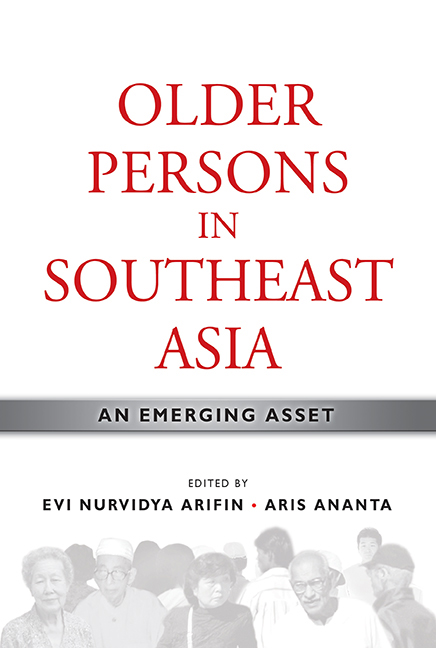Book contents
- Frontmatter
- Contents
- List of Tables
- List of Figures
- Foreword by Hal Hill
- Message from the Director
- Preface
- Contributors
- PART I INTRODUCTION
- PART II OLD-AGE INCOME SECURITY
- PART III EMPLOYMENT AND OTHER SOURCES OF FINANCIAL CONTRIBUTION
- 7 Employment of Older Persons: Diversity across Nations and Subnations in Southeast Asia
- 8 Work, Income, and Expenditure: Elderly and Near-elderly Women in Metro Cebu, Philippines
- 9 Employability Approach to Financing Old Age
- 10 Facing the Geriatric Wave in Indonesia: Financial Conditions and Social Support
- PART IV AGEING, MIGRATION, AND DEVELOPMENT
- PART V ROLES OF GOVERNMENT AND CIVIL SOCIETY
- Index
8 - Work, Income, and Expenditure: Elderly and Near-elderly Women in Metro Cebu, Philippines
from PART III - EMPLOYMENT AND OTHER SOURCES OF FINANCIAL CONTRIBUTION
Published online by Cambridge University Press: 21 October 2015
- Frontmatter
- Contents
- List of Tables
- List of Figures
- Foreword by Hal Hill
- Message from the Director
- Preface
- Contributors
- PART I INTRODUCTION
- PART II OLD-AGE INCOME SECURITY
- PART III EMPLOYMENT AND OTHER SOURCES OF FINANCIAL CONTRIBUTION
- 7 Employment of Older Persons: Diversity across Nations and Subnations in Southeast Asia
- 8 Work, Income, and Expenditure: Elderly and Near-elderly Women in Metro Cebu, Philippines
- 9 Employability Approach to Financing Old Age
- 10 Facing the Geriatric Wave in Indonesia: Financial Conditions and Social Support
- PART IV AGEING, MIGRATION, AND DEVELOPMENT
- PART V ROLES OF GOVERNMENT AND CIVIL SOCIETY
- Index
Summary
Unlike most countries in East Asia and some of its Southeast Asian neighbours, the Philippines has not been confronted yet with the immediate problems of a rapidly ageing population. Because fertility decline has been slow and the demographic transition has been a protracted experience, the Philippines remains embroiled in problems concomitant with a young and fast-growing population. The annual growth rate of the Philippines' population was at 2.36 per cent during 1995–2000 (according to 2000 Population Census report) and 2.04 per cent during 2000–2007 (according to 2007 Population Census report). The National Statistical Coordination Board/NSCB (2008) and the 2003 National Demographic and Health Survey (NDHS) reported TFR (Total Fertility Rate) at 3.5 births, only a slight decline from 3.7 births in 1998, and 4.1 births in 1993 (NSO and ORC Macro 2004). Xenos (2004) has estimated that the Philippines will take some sixty-six years to complete its demographic transition, possibly among the slowest transitions in Asia. These trends may be attributed in part to the country' population programme which has been sporadic and inconsistent because of a long-standing opposition of the Catholic Church hierarchy to the promulgation and implementation of a clear, unequivocal population policy (Herrin 2003). The current policy advocates “responsible parenthood”, promoting the practice of scientific, natural family planning (POPCOM 2007).
Nonetheless, since fertility has gradually declined, and mortality conditions have improved in the last decades, the country' age-structural transition is clearly underway. Life expectancy at birth has been estimated to rise from the 1960 levels of 51.0 years for men and 54.5 years for women, to 62.2 and 67.4 years, respectively, in 1990 (Flieger, Abenoja, and Lim 1981; Flieger and Cabigon 1994). The National Statistics Office computed life expectancy to increase further to 70.0 years for males and 75.5 years for females by 2020–25 (NSO 2004).
At present, the country is still experiencing a youth bulge, with relatively large proportions of its population in their adolescent to early adult years. In due time these young people will grow old. In absolute numbers, there are about twenty-one million Filipinos aged 15–29 in 2000, who, in two decades, will be in their mid-adult years and moving onward to older ages.
- Type
- Chapter
- Information
- Older Persons in Southeast AsiaAn Emerging Asset, pp. 218 - 243Publisher: ISEAS–Yusof Ishak InstitutePrint publication year: 2009



